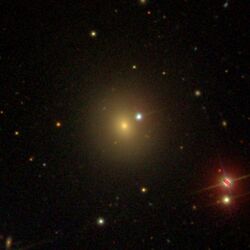Astronomy:NGC 2800
From HandWiki
Short description: Elliptical galaxy in the constellation Ursa Major
| NGC 2800 | |
|---|---|
 SDSS image of NGC 2800 | |
| Observation data (J2000 epoch) | |
| Constellation | Ursa Major |
| Right ascension | 09h 18m 35.164s[1] |
| Declination | +52° 30′ 52.49″[1] |
| Redshift | 0.025338[2] |
| Helio radial velocity | 7500 km/s[2] |
| Distance | 374.4 ± 26.3 Mly (114.80 ± 8.05 Mpc)[3] |
| Apparent magnitude (B) | 14.0[2] |
| Characteristics | |
| Type | E[3] |
| Other designations | |
| UGC 4920, MCG+09-15-117, PGC 26302[2] | |
NGC 2800, also known as PGC 26302, is an elliptical galaxy in the constellation Ursa Major. It was discovered February 17, 1831 by William Herschel.[4]
References
- ↑ Jump up to: 1.0 1.1 Skrutskie, Michael F.; Cutri, Roc M.; Stiening, Rae; Weinberg, Martin D.; Schneider, Stephen E.; Carpenter, John M.; Beichman, Charles A.; Capps, Richard W. et al. (1 February 2006). "The Two Micron All Sky Survey (2MASS)". The Astronomical Journal 131 (2): 1163–1183. doi:10.1086/498708. ISSN 0004-6256. Bibcode: 2006AJ....131.1163S. https://ui.adsabs.harvard.edu/abs/2006AJ....131.1163S/abstract.
- ↑ Jump up to: 2.0 2.1 2.2 2.3 "NGC 2800". SIMBAD. Centre de données astronomiques de Strasbourg. http://simbad.u-strasbg.fr/simbad/sim-basic?Ident=NGC+2800.
- ↑ Jump up to: 3.0 3.1 "Results for object NGC 2800 (NGC 2800)". NASA/IPAC Extragalactic Database. California Institute of Technology. https://ned.ipac.caltech.edu/byname?objname=NGC%202800&hconst=67.8&omegam=0.308&omegav=0.692&wmap=4&corr_z=1. Retrieved 2020-06-05.
- ↑ "New General Catalog Objects: NGC 2800 - 2849". https://cseligman.com/text/atlas/ngc28.htm.
External links
 |

